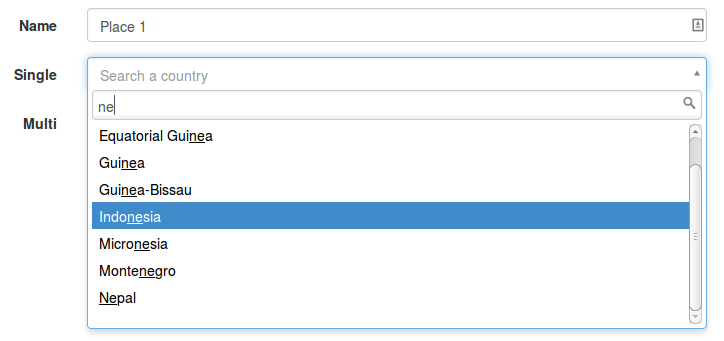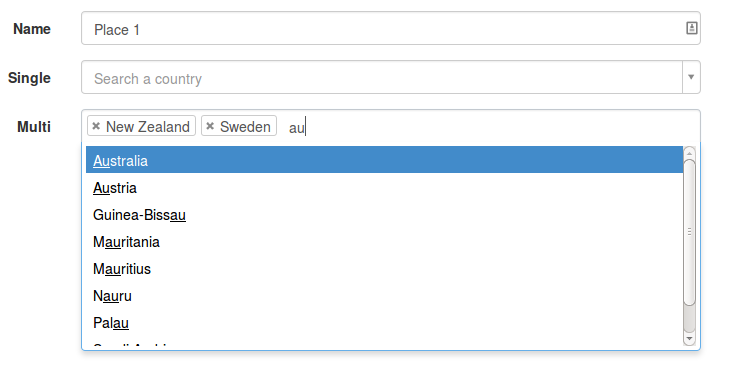brunops / select24entity-bundle
It's a Symfony2 bundle that integrates Select2 as a drop-in replacement for a standard entity field on a Symfony form.
Installs: 347
Dependents: 0
Suggesters: 0
Security: 0
Stars: 2
Watchers: 0
Forks: 100
Open Issues: 0
Type:symfony-bundle
pkg:composer/brunops/select24entity-bundle
Requires
- php: >=5.4.0
- doctrine/orm: >=2.4
- symfony/symfony: >=2.2
This package is not auto-updated.
Last update: 2023-04-01 11:10:24 UTC
README
Fork description
This bundle is a fork of the original Select2Entity by Tetranz.
The goal of this fork is to modify the bundle to mimick Select2 behavior, meaning leaving the activation and the configuration of the field to the user in the javascript itself, at the exception of AJAX retrieval of the entities.
Introduction
This is a Symfony2 bundle which enables the popular Select2 component to be used as a drop-in replacement for a standard entity field on a Symfony form.
The main feature that this bundle provides compared with the standard Symfony entity field (rendered with a html select) is that the list is retrieved via a remote ajax call. This means that the list can be of almost unlimited size. The only limitation is the performance of the database query or whatever that retrieves the data in the remote web service.
It works with both single and multiple selections. If the form is editing a Symfony entity then these modes correspond with many to one and many to many relationships. In multiple mode, most people find the Select2 user interface easier to use than a standard select tag with multiple=true with involves awkward use of the ctrl key etc.
The project was inspired by lifo/typeahead-bundle which uses the Typeahead component in Bootstrap 2 to provide similar functionality. Select24Entity can be used anywhere Select2 can be installed, including Bootstrap 3.
Thanks to @ismailbaskin we now have Select2 version 4 compatibility.
Screenshots
This is a form with a single selection field list expanded.
This is a form with a multiple selection field list expanded.
Installation
Select2 must be installed and working first.
-
select2.js, select2.css from https://github.com/select2/select2
-
If you want it integrated in bootstrap, select2-bootstrap.css from https://github.com/select2/select2-bootstrap-theme
These files live in the Resources/public/js and Resources/public/css folders of one of my bundles and then included in my main layout.html.twig file.
Alternatively, minified versions of select2.js and select2.css can be loaded from the CloudFlare CDN using the two lines of code given here: https://select2.github.io. Make sure the script tag comes after where jQuery is loaded. That might be in the page footer.
- Add
brunops/select24entity-bundleto your projectscomposer.json"requires" section:
{ // ... "require": { // ... "brunops/select24entity-bundle": "dev-master" } }
Note that this only works with Select2 version 4.
- Run
php composer.phar update brunops/select24entity-bundlein your project root. - Update your project
app/AppKernel.phpfile and add this bundle to the $bundles array:
$bundles = array( // ... new Brunops\Select24EntityBundle\BrunopsSelect24EntityBundle(), );
- Update your project
app/config.ymlfile to provide global twig form templates:
twig: form_themes: - 'BrunopsSelect24EntityBundle:Form:fields.html.twig'
- Load the Javascript on the page. The simplest way is to add the following to your layout file. Don't forget to run console assets:install. Alternatively, do something more sophisticated with Assetic.
<script src="{{ asset('bundles/brunopsselect24entity/js/select24entity.js') }}"></script>
How to use
The following works on Symfony 2.8 (and probably Symfony 3, but not tested yet).
Select24Entity is simple to use. In the buildForm method of a form type class, specify Select24EntityType::class as the type where you would otherwise use entity:class.
Here's an example:
$builder ->add('country', Select24EntityType::class, [ 'multiple' => true, 'remote_route' => 'brunops_test_default_countryquery', 'class' => '\Brunops\TestBundle\Entity\Country', 'primary_key' => 'id', 'text_property' => 'name', 'minimum_input_length' => 2, 'page_limit' => 10, 'allow_clear' => true, 'delay' => 250, 'cache' => true, 'cache_timeout' => 60000, // if 'cache' is true 'language' => 'en', 'placeholder' => 'Select a country', ])
Put this at the top of the file with the form type class:
use Brunops\Select24EntityBundle\Form\Type\Select24EntityType;
In the template where you will use the field, you must activate it like you would with any Select2 field, using something like this:
$('.select24entity').select24entity();
Inside the parenthesis, you can pass any options that Select2 can accept.
Options
Defaults will be used for some if not set.
classis your entity class. Requiredprimary_keyis the name of the property used to uniquely identify entities. Defaults to 'id'text_propertyThis is the entity property used to retrieve the text for existing data. If text_property is omitted then the entity is cast to a string. This requires it to have a __toString() method.multipleTrue for multiple select (many to many). False for single (many to one) select.minimum_input_lengthis the number of keys you need to hit before the search will happen. Defaults to 2.page_limitThis is passed as a query parameter to the remote call. It is intended to be used to limit size of the list returned. Defaults to 10.allow_clearTrue will cause Select2 to display a small x for clearing the value. Defaults to false.delayThe delay in milliseconds after a keystroke before trigging another AJAX request. Defaults to 250 ms.placeholderPlaceholder text.languagei18n language code. Defaults to en.cacheEnable AJAX cache. Results will be cached for each 'term' queried.cache_timeoutHow long to cache a query in milliseconds. Setting to0will cause the cache to never timeout (60000 = 60 seconds)transformerThe fully qualified class name of a custom transformer if you need that flexibility as described below.
The url of the remote query can be given by either of two ways: remote_route is the Symfony route. remote_params can be optionally specified to provide parameters. Alternatively, remote_path can be used to specify the url directly.
The defaults can be changed in your app/config.yml file with the following format.
brunops_select24entity: minimum_input_length: 2 page_limit: 8 allow_clear: true delay: 500 language: fr cache: false cache_timeout: 0
AJAX Response
The controller should return a JSON array in the following format. The properties must be id and text.
[ { id: 1, text: 'Displayed Text 1' }, { id: 2, text: 'Displayed Text 2' } ]
Select2 Taggable fields
If you want to use Select2 Tags fields, you need to do two things:
- Activate the field with tags attribute to true:
$(".select24entity").select24entity({ tags: true });
- Define a Data Transformer that act similar to this:
// Transform should return the same thing as the argument, Select24Entity will do the job. public function transform($entities) { return $entities; } // This data transformer will receive the entities already parsed through the Select24Entity data transformer, alongside a key 'toCreate' if there is something to create. public function reverseTransform($entities) { if ($entities->containsKey('toCreate')) { $toCreate = $entities->get('toCreate'); $entities->remove('toCreate'); // We need to remove the key so that the Symfony Form component won't try to read it as if it was of same type of all other $entities // Simple loop to create the entities. Don't forget to persist them! foreach ($toCreate as $value) { if ($this->is_valid($value)) { // Some validation $newEntity = $this->createAndPersistEntity($value); // Create the entity object and persist it $entities->add($newEntity); // Add the entity to the ArrayCollection } } } return $entities; }
##Custom option text##
If you need more flexibility in what you display as the text for each option, such as displaying the values of several fields from your entity or showing an image inside, you may define your own custom transformer.
Your transformer must implement DataTransformerInterface. The easiest way is probably to extend EntityToPropertyTransformer or EntitiesToPropertyTransformer and redefine the transform() method. This way you can return as text anything you want, not just one entity property.
Here's an example that returns the country name and continent (two different properties in the Country entity):
$builder ->add('country', Select24EntityType::class, [ 'multiple' => true, 'remote_route' => 'brunops_test_default_countryquery', 'class' => '\Brunops\TestBundle\Entity\Country', 'transformer' => '\Brunops\TestBundle\Form\DataTransformer\CountryEntitiesToPropertyTransformer', ]);
In transform sets data array like this:
$data[] = array( 'id' => $country->getId(), 'text' => $country->getName().' ('.$country->getContinent()->getName().')', );
Your custom transformer and respectively your Ajax controller should return an array in the following format:
[ { id: 1, text: 'United Kingdom (Europe)' }, { id: 1, text: 'China (Asia)' } ]
###Templating###
If you need Templating in Select2, you could consider the following example that shows the country flag next to each option.
Your custom transformer should return data like this:
[ { id: 1, text: 'United Kingdom (Europe)', img: 'images/flags/en.png' }, { id: 2, text: 'China (Asia)', img: 'images/flags/ch.png' } ]
You need to define your own JavaScript function select24entityAjax which extends the original one select24entity and display custom template with image:
$.fn.select24entityAjax = function(action) { var action = action || {}; var template = function (item) { var img = item.img || null; if (!img) { if (item.element && item.element.dataset.img) { img = item.element.dataset.img; } else { return item.text; } } return $( '<span><img src="' + img + '" class="img-circle img-sm"> ' + item.text + '</span>' ); }; this.select24entity($.extend(action, { templateResult: template, templateSelection: template })); return this; }; $('.select2entity').select24entityAjax();
This script will add the functionality globally for all elements with class select24entity, but if the img is not passed it will work as the original select24entity.
You also will need to override the following block in your template:
{% block brunops_select24entity_widget_select_option %}
<option value="{{ label.id }}" selected="selected"
{% for key, data in label %}
{% if key not in ['id', 'text'] %} data-{{ key }}="{{ data }}"{% endif %}
{% endfor %}>
{{ label.text }}
</option>
{% endblock %}
This block adds all additional data needed to the JavaScript function select24entityAjax, like data attribute. In this case we are passing data-img.
##Embed Collection Forms##
If you use Embedded Collection Forms and data-prototype to add new elements in your form, you will need the following JavaScript that will listen for adding an element .select24entity:
$('body').on('click', '[data-prototype]', function(e) { $(this).prev().find('.select24entity').last().select24entity(); });


